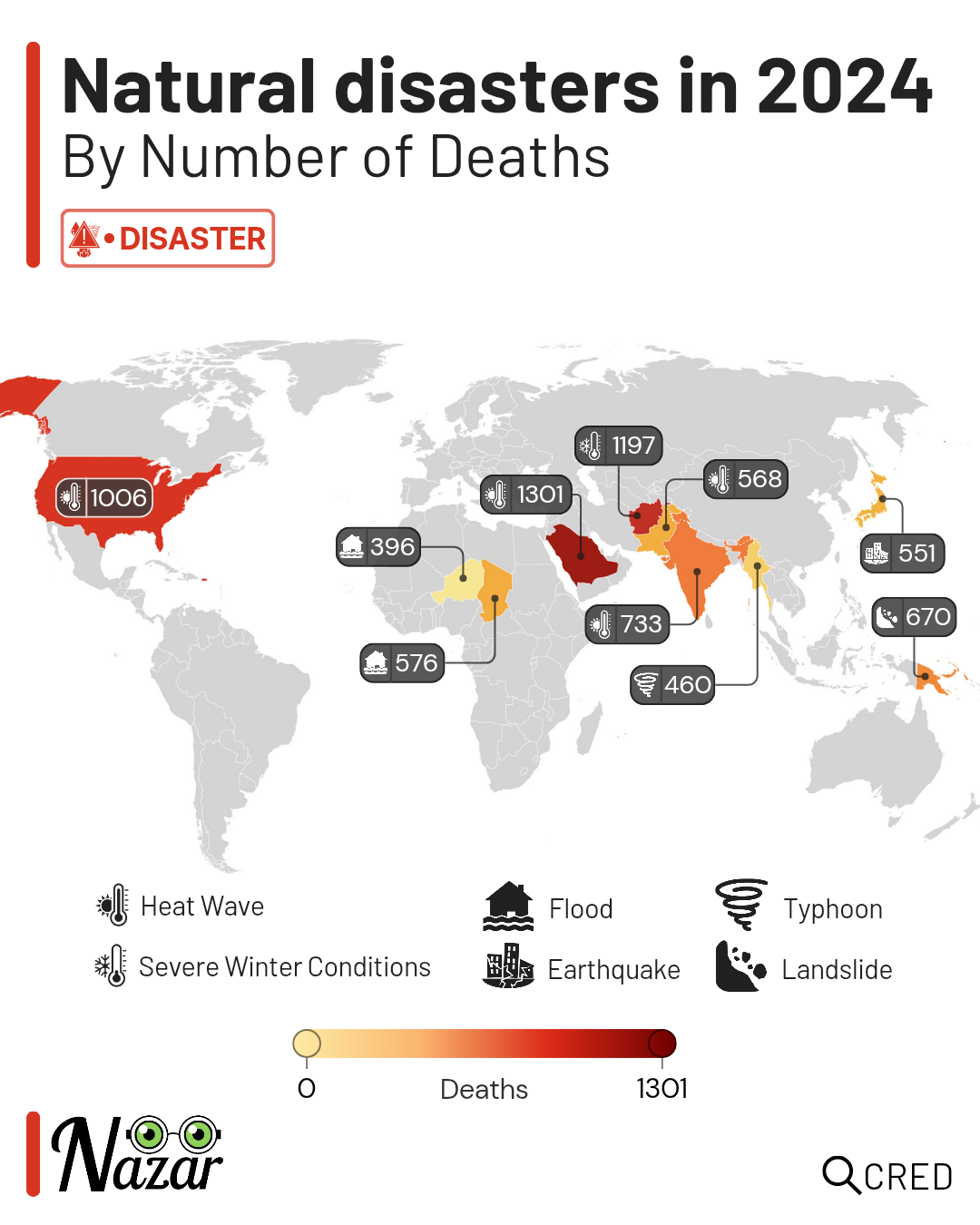Natural Disasters in 2024 Map


David Chen
Data Visualization Specialist
David Chen is an expert in transforming complex geographic datasets into compelling visual narratives. He combines his background in computer science ...
Geographic Analysis
What This Map Shows
The "Natural Disasters in 2024 Map" provides a stark visualization of the human toll inflicted by various natural disasters across the globe in a single year. From catastrophic flooding in Africa to deadly heatwaves in the United States and South Asia, this map highlights the pervasive impact of climate change and extreme weather events. As we delve deeper into this topic, it becomes clear that understanding the patterns and consequences of natural disasters is critical for preparedness and response.
Deep Dive into Natural Disasters
Natural disasters are catastrophic events that result from natural processes of the Earth. They include floods, hurricanes, earthquakes, wildfires, and heatwaves, each with distinct characteristics and causes. The year 2024 showcased the devastating effects of these events, underscoring the increasing frequency and severity associated with climate change.
Interestingly, heatwaves emerged as one of the deadliest forms of natural disaster in developed countries. In the United States alone, over 1,000 lives were lost due to extreme heat, revealing a troubling trend where climate extremes are becoming deadlier even in regions typically better equipped to handle such crises. This phenomenon raises important questions about societal vulnerabilities and the need for robust climate adaptation strategies.
Flooding was another significant disaster in 2024, particularly in Africa. The floods in Chad and surrounding countries claimed nearly 1,000 lives, marking it as the deadliest disaster of the year. Floods often occur due to heavy rainfall, rapid snowmelt, or storm surges, and their effects can be devastating, leading to loss of life, property damage, and long-term economic repercussions. Countries in this region, already grappling with other challenges, faced additional burdens as they struggled to respond to this crisis.
In South Asia, where heatwaves are typically less common, the year 2024 saw a shocking increase in fatalities, with over 1,300 deaths attributed to extreme temperatures. This highlights a concerning trend where regions that once experienced milder climates are now facing the brunt of climate extremes.
Moreover, even nations that are generally less prone to natural disasters, such as Japan and Afghanistan, were not spared in 2024. Earthquakes and extreme weather events resulted in 551 and 733 deaths, respectively. This serves as a reminder that no area is immune to the effects of climate change, and preparedness is vital everywhere.
Regional Analysis
Examining the data provided by the map reveals stark contrasts between regions. In the United States, the combination of urban heat islands and aging infrastructure exacerbates the impacts of heatwaves. Vulnerable populations, particularly the elderly and those with pre-existing health conditions, are disproportionately affected.
Conversely, in Chad and surrounding countries, the interplay of socio-economic factors such as poverty, inadequate infrastructure, and lack of disaster preparedness significantly increased the vulnerability of communities to flooding. These regions often lack the resources for effective emergency response, leading to higher casualty rates.
In South Asia, the combination of high population density and limited access to cooling resources makes heatwaves particularly lethal. The challenges are compounded by socio-economic disparities, where marginalized communities face greater risks due to inadequate housing and healthcare systems.
Interestingly, the data from Japan and Afghanistan illustrates how even technologically advanced nations like Japan can experience significant disaster impacts. Although Japan has a robust disaster management system, the earthquake and subsequent effects still led to substantial loss of life. Afghanistan, with its ongoing conflicts and instability, faces challenges in disaster preparedness, further exacerbating the impact of natural events.
Significance and Impact
Understanding the patterns of natural disasters is crucial for several reasons. Firstly, it highlights the urgent need for improved disaster preparedness and response strategies. As climate change continues to intensify, the frequency and severity of these disasters are likely to rise, emphasizing the necessity for global cooperation in addressing climate issues.
Moreover, the human cost of natural disasters extends beyond immediate fatalities. The aftermath often includes long-term psychological, economic, and social impacts on affected communities. The need for effective policy responses that prioritize vulnerable populations is more critical than ever.
Looking ahead, projections suggest that without significant action to mitigate climate change, we may see even more severe natural disasters in the coming years. Communities, governments, and organizations must work collaboratively to develop adaptive strategies and invest in resilience-building measures.
In conclusion, the "Natural Disasters in 2024 Map" serves as a stark reminder of the challenges posed by climate change and the urgent need for global action. By understanding the geographic distribution and human impact of these disasters, we can better prepare for the future and strive to protect lives and livelihoods across the globe.
Visualization Details
- Published
- October 1, 2025
- Views
- 52
Comments
Loading comments...